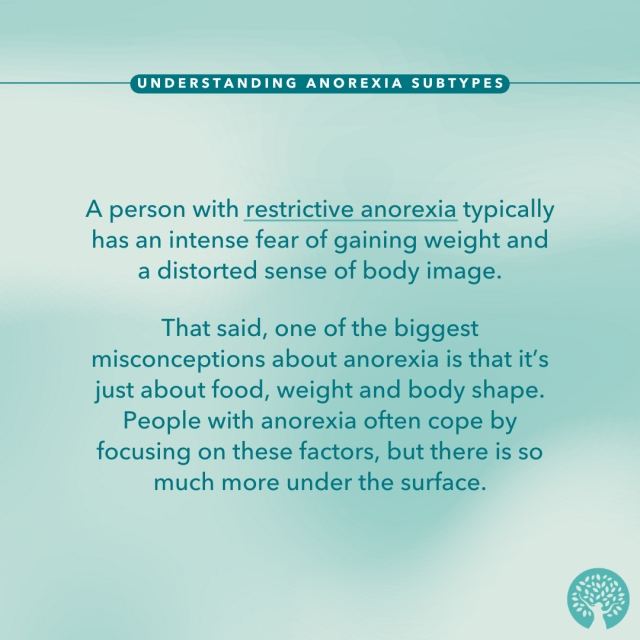Anorexia Nervosa Subtypes: Understanding Restricting Type and Binge-Eating/Purging Type
Clinically reviewed by:
Elizabeth Easton, PsyD, CEDS
Table of Contents
There are two subtypes of anorexia nervosa: restricting type (AN-R) and binge-eating/purging type (AN-BP). In this piece, Elizabeth Easton, PsyD, CEDS, national director of psychotherapy at Eating Recovery Center (ERC), discusses both types. This content is intended to provide clarity regarding the diagnostic criteria of anorexia nervosa. ERC acknowledges that this diagnostic criteria is limiting and not weight-inclusive. Persons in larger bodies can also have restrictive anorexia, which we discuss in this piece.
What is the restricting subtype of anorexia?
A person with restrictive anorexia typically has an intense fear of gaining weight and a distorted sense of body image. That said, one of the biggest misconceptions about anorexia is that it’s just about food, weight and body shape. People with anorexia often cope by focusing on these factors -- but there is much more under the surface.
“While the distress connected to food, weight and body size is very real and incredibly overwhelming, the larger concern is the avoidance of distress itself,” says Dr. Easton. “People with anorexia nervosa move away from psychological pain instead of moving through it and building resilience.”
Strictly speaking of behaviors, this subtype is characterized by a focus on weight loss through one or more of the following:
- Dieting
- Fasting
- Excessive physical activity

Symptoms of restricting type of anorexia
Behavioral and physical symptoms of AN-R include:
- A shift in eating habits: A person with restrictive anorexia may demonstrate sudden shifts and concerning habits related to eating and food. This might look like calorie restriction, food obsession, refusal of food, piqued interest in fad diets, denial of hunger and other specific food-related rituals.
- Low weight* or sudden weight loss: This symptom may not always be obvious and will depend on a person’s age, sex, developmental stage and physical health. Low weight can be defined as weight less than minimally expected considering these factors. Someone who is experiencing restrictive anorexia may have a significant or dramatic decrease in their weight, especially over a short period of time.
- Hypotension and orthostasis: A person with restrictive anorexia often is not getting the right amount of nutrition, so they may experience low blood pressure (below 90/60 mm Hg) and orthostasis, which occurs when blood pressure drops due to a positional change (i.e., standing or sitting up).
- Hair thinning or hair loss: Another physical symptom one may experience is hair thinning or hair loss due to nutritional deficiencies.
- Irregular periods: Someone may experience an absence of or delayed onset of their menstrual cycle, or experience a lighter than normal menstrual cycle. Other hormonal changes can occur, affecting males as well.
*People in larger bodies can also experience restrictive anorexia. Learn more about atypical anorexia here.
What is the binge-eating/purging type of anorexia?
The binge-eating/purging type of anorexia is characterized by recurrent episodes of bingeing, which includes eating large amounts of food in a relatively short time while experiencing a sense of loss of control.
This binge is usually followed by a variety of “compensatory” behaviors, or purging, aimed at regaining control of weight. Purging may include self-induced vomiting, abuse of laxatives and diuretics, or excessive physical activity.

Symptoms of binge-eating/purging type of anorexia
Behavioral and physical symptoms of AN-BP include:
- Consumption of large amounts of food in a short period of time (bingeing)
- Use of behaviors to compensate for calories consumed, including self-induced vomiting, restricting/fasting, overexercising and/or using laxatives or diuretics
- Feeling “out of control” or ashamed over how much you eat
- Fear of gaining weight
- Self-esteem and self-worth tied heavily to body shape and weight
- Withdrawal from friends, family and “normal” activities/routines
- Failing performance in work, school and athletic engagements
- Low or abnormal labs (can include electrolyte abnormalities)
- Swelling of the cheeks or jaw
- Calluses on the back of the hands and knuckles
How is anorexia binge-eating/purging type different from bulimia nervosa?
While the binge and purge behaviors in bulimia nervosa and binge-purge anorexia can look very similar, the primary difference in the diagnostic criteria for binge-purge anorexia is that the person has a low body weight for their age and height and/or a period of significant weight loss.
This diagnostic criteria is problematic and exclusionary because weight is not an indicator of health. At ERC, we provide individualized treatment plans for anyone diagnosed with bulimia nervosa or binge-purge anorexia, as identified by their care team.
Read more on bulimia nervosa here.
Causes of anorexia
There is no single cause of either subtype of anorexia but rather an amalgamation of many factors, including:
- Genetics
- Temperament
- Co-occurring depression or anxiety
- Traumatic experiences and trauma-related symptoms
- Support system conflict
- Emotion regulation challenges (such as high impulsivity)
Role of genetics in anorexia
There are genetic causes of both subtypes of anorexia, though there is not a specific anorexia gene. Researchers have identified correlations, and possible genetic overlap, between anorexia nervosa and other psychiatric disorders such as depression, anxiety and obsessive-compulsive disorder, as well as certain personality traits. The heritable nature of these traits, including harm avoidance, perfectionism and inflexibility, suggests the relationships may be genetic. There are also studies that show that anorexia nervosa, as well as other eating disorders, runs in families.
The heritability of anorexia has been reported between 40% and 60%, and relatives of individuals with anorexia nervosa are 11 times more likely to develop the illness than relatives of individuals without anorexia. In simpler terms, although we do not inherit anorexia per se, we can inherit a vulnerability to anorexia. There are also cultural causes of anorexia nervosa, including weight stigma and anti-fat bias.
Treatment for anorexia
Lasting recovery from both subtypes of anorexia nervosa is possible.
“At the heart of it, anorexia is a conditioned response to try to feel safe or less overwhelmed,” explains Dr. Easton. “In order to return to wellness, we must address that conditioned response, starting with a person’s focus on food, weight and body size, then move into other areas of distress.”
In most cases, sustainable recovery begins with nutritional rehabilitation and weight restoration. Why is this so important, if eating disorders aren’t really “about food”? When someone is severely malnourished, their brain isn't able to process the thoughts, feelings and behavior changes needed to break the cycle of their eating disorder. Making sure their body and brain are getting the nutrients they need to be able to properly function and think clearly is the first step.
Treatment for both subtypes of anorexia nervosa is very similar across the board. However, “at ERC we do treat patients with binge-purge anorexia with additional support before, during and following mealtimes when their impulses to use behaviors are at their highest,” says Dr. Easton. “This may include prior planning for use of individual coping skills and direct support from trained staff to help them move through their urges without using unhelpful behaviors.”
Addressing co-occurring conditions of anorexia
To target underlying causes, including anxiety and other co-occurring conditions, our team leverages a variety of evidence-based therapies, including cognitive behavioral therapy (CBT), dialectical behavior therapy (DBT), exposure therapy, acceptance and commitment therapy (ACT) and more. The skills patients build using these therapies benefit them not only while they’re in our care, but for the rest of their lives.
Our inpatient and residential treatment programs include round-the-clock nursing supervision, psychiatric care and medication management. We also provide nourishing meals and psychosocial support to help patients make progress in recovery so they can step down to lower levels of care.
To help patients build a foundation for recovery at all levels of care, ERC also offers:
- Nutrition education and support from registered dietitians (more on this below)
- Comprehensive family and caregiver support
- Alumni support
- Support groups and community events
Our nutrition approach
We work with each patient to heal their relationship with food, so meals and snacks are an important part of anorexia treatment.
If a patient has been restricting foods, bingeing or purging, they’ll be prescribed a personalized nutrition plan based on their symptoms, underlying medical conditions and how long their eating disorder has been present. After meeting with registered dietitians and therapists regularly, receiving education on food portions, meal plating and nutrition, the goal is for each patient to develop a peaceful relationship with food.
Learn more about our nutrition approach here.
We believe -- and have seen -- that healing is possible. Looking for support? Schedule a free assessment by calling 877-825-8584 today.
This blog was clinically reviewed by Elizabeth Easton, PsyD, CEDS, in September 2023.
Read These Next:
- 5 Self-Advocacy Tips for Fat Folks in Eating Disorder Recovery by Sharon Maxwell
- Feeling Anxious about Weight Restoration in Anorexia Recovery
- Anorexia in Teens
- Anorexia in Males
- Anorexia vs. Bulimia: What's the Difference?
- Lanugo: Anorexia Hair Growth Explained
- Exercise in Anorexia Recovery: Is It Safe?
Struggling with an eating disorder?
One conversation can make all the difference. Connect with us today.
Get Help NowConnect With Us

